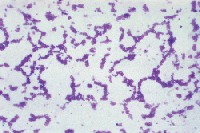The golden pigment that coats the exterior of Staphylococus aureus is what fights off the bodys immune system, according to a study in Julys Journal of Experimental Medicine.
Scientists from the University of California, San Diego, in La Jolla, Calif., came to this conclusion after they compared a wild strain of Staphylococcus aureus with a strain they created that lacked the golden pigment and placed both strains into the skin of mice.
Results showed that the genetically engineered, white-colored strain was more susceptible to oxidant killing, had impaired neutrophil (forms of white blood cells) survival and was less pathogenic than the wild strain. Why? The golden pigment is made from carotenoidsanti-oxidantswhich enable Staphylococus aureus to withstand the attack of the immune systems neutrophils, which produce oxidative bursts that destroy a majority of the bacteria, the scientists found.
So, could this finding be the answer to defeating resistant strains of bacteria, such as methicillin-resistant Staphylococcus aureus (MRSA)? That may be an overstatement, says optometrist Joseph P. Shovlin, who has seen treated MRSA corneal ulcers at his Scranton, Pa., practice. This study is another exciting approach that works to convert bacterial mutants in the lab. The real challenge is to make it applicable in the clinical world.
This finding gives drug manufacturers a potential new target to fight bacteria through a modified anti-sense therapy by blocking anti-oxidant properties of certain bacteria, he says.
Scientists from the University of California, San Diego, in La Jolla, Calif., came to this conclusion after they compared a wild strain of Staphylococcus aureus with a strain they created that lacked the golden pigment and placed both strains into the skin of mice.
 |
| The golden pigment that coats the exterior of Staphylococus aureus is this bacterias armor, researchers say. |
Results showed that the genetically engineered, white-colored strain was more susceptible to oxidant killing, had impaired neutrophil (forms of white blood cells) survival and was less pathogenic than the wild strain. Why? The golden pigment is made from carotenoidsanti-oxidantswhich enable Staphylococus aureus to withstand the attack of the immune systems neutrophils, which produce oxidative bursts that destroy a majority of the bacteria, the scientists found.
So, could this finding be the answer to defeating resistant strains of bacteria, such as methicillin-resistant Staphylococcus aureus (MRSA)? That may be an overstatement, says optometrist Joseph P. Shovlin, who has seen treated MRSA corneal ulcers at his Scranton, Pa., practice. This study is another exciting approach that works to convert bacterial mutants in the lab. The real challenge is to make it applicable in the clinical world.
This finding gives drug manufacturers a potential new target to fight bacteria through a modified anti-sense therapy by blocking anti-oxidant properties of certain bacteria, he says.
Liu GY, Essex A, Buchanan JT, et al. Staphylococcus aureus golden pigment impairs neutrophil killing and promotes virulence through its antioxidant activity. J Exp Med 2005 Jul 18;202(2):209-15. Epub 2005 Jul 11.
Vol. No: 142:8Issue:
8/15/2005

